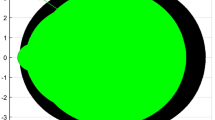Abstract
The positive definiteness of elasticity tensors plays an important role in the elasticity theory. In this paper, we consider the bi-block symmetric tensors, which contain elasticity tensors as a subclass. First, we define the bi-block M-eigenvalue of a bi-block symmetric tensor, and show that a bi-block symmetric tensor is bi-block positive (semi)definite if and only if its smallest bi-block M-eigenvalue is (nonnegative) positive. Then, we discuss the distribution of bi-block M-eigenvalues, by which we get a sufficient condition for judging bi-block positive (semi)definiteness of the bi-block symmetric tensor involved. Particularly, we show that several classes of bi-block symmetric tensors are bi-block positive definite or bi-block positive semidefinite, including bi-block (strictly) diagonally dominant symmetric tensors and bi-block symmetric (B)B0-tensors. These give easily checkable sufficient conditions for judging bi-block positive (semi)definiteness of a bi-block symmetric tensor. As a byproduct, we also obtain two easily checkable sufficient conditions for the strong ellipticity of elasticity tensors.
Similar content being viewed by others
References
Che H, Chen H, Wang Y. On the M-eigenvalue estimation of fourth-order partially symmetric tensors. J Ind Manag Optim, 2020, 16: 309–324
Chirită S, Ghiba I-D. Strong ellipticity and progressive waves in elastic materials with voids. Proc R Soc Lond A, 2010, 466: 439–458
Choi M D. Positive semidefinite biquadratic forms. Linear Algebra Appl, 1975, 12: 95–100
Ding W, Liu J, Qi L, Yan H. Elasticity M-tensors and the strong ellipticity condition. Appl Math Comput, 2020, 373: 124982
Ding W, Luo Z, Qi L. P-tensors, P0-tensors, and their applications. Linear Algebra Appl, 2018, 555: 336–354
Ding W, Qi L, Wei Y. M-tensors and nonsingular M-tensors. Linear Algebra Appl, 2013, 439: 3264–3278
Ding W, Qi L, Yan H. On some sufficient conditions for strong ellipticity. arXiv: 1705.05081
Han D, Dai H H, Qi L. Conditions for strong ellipticity of anisotropic elastic material. J Elasticity, 2009, 97: 1–13
Han D, Qi L. A successive approximation method for quantum separability. Front Math China, 2013, 8: 1275–1293
Haussühl S. Physical Properties of Crystals: An Introduction. Weinheim: Wiley-VCH Verlag, 2007
He J, Li C, Wei Y. M-eigenvalue intervals and checkable sufficient conditions for the strong ellipticity. Appl Math Lett, 2020, 102: 106137
Hu S, Huang Z H. Alternating direction method for bi-quadratic programming. J Global Optim, 2011, 51: 429–446
Hu S, Huang Z H, Ling C, Qi L. On determinants and eigenvalue theory of tensors. J Symbolic Comput, 2013, 50: 508–531
Hu S, Qi L, Song Y, Zhang G. Geometric measure of entanglement of multipartite mixed states. Int J Software Informatics, 2014, 8: 317–326
Hu S, Qi L, Zhang G. Computing the geometric measure of entanglement of multipartite pure states by means of non-negative tensors. Phys Rev A, 2016, 93: 012304
Huang Z H, Qi L. Positive definiteness of paired symmetric tensors and elasticity tensors. J Comput Appl Math, 2018, 338: 22–43
Huang Z H, Qi L. Tensor complementarity problems-part I: basic theory. J Optim Theory Appl, 2019, 183: 1–23
Li S, Li C, Li Y. M-eigenvalue inclusion intervals for a fourth-order partially symmetric tensor. J Comput Appl Math, 2019, 356: 391–401
Li S H, Li Y T. Bounds for the M-spectral radius of a fourth-order partially symmetric tensor. J Inequal Appl, 2018, 2018: 18, https://doi.org/10.1186/s13660-018-1610-5
Ling C, Nie J, Qi L, Ye Y. Bi-quadratic optimization over unit spheres and semidefinite programming relaxations. SIAM J Optim, 2009, 20: 1286–1310
Nie J, Zhang X Z. Positive maps and separable matrices. SIAM J Optim, 2016, 26: 1236–1256
Peña J M. A class of P-matrices with applications to the localization of the eigenvalues of a real matrix. SIAM J Matrix Anal Appl, 2001, 22: 1027–1037
Peña J M. On an alternative to Gerschgorin circles and ovals of Cassini. Numer Math, 2003, 95: 337–345
Qi L. Eigenvalues of a real supersymmetric tensor. J Symbolic Comput, 2005, 40: 1302–1324
Qi L, Dai H H, Han D. Conditions for strong ellipticity and M-eigenvalues. Front Math China, 2009, 4: 349–364
Qi L, Huang Z H. Tensor complementarity problems-part II: solution methods. J Optim Theory Appl, 2019, 183: 365–385
Qi L, Luo Z. Tensor Analysis: Spectral Properties and Special Tensors. Philadelphia: SIAM, 2017
Qi L, Song Y. An even order symmetric B tensor is positive definite. Linear Algebra Appl, 2014, 457: 303–312
Rosakis P. Ellipticity and deformations with discontinuous deformation gradients in finite elastrostatics. Arch Ration Mech Anal, 1990, 109: 1–37
Sfyris D. The strong ellipticity condition under changes in the current and reference configuration. J Elasticity, 2011, 103: 281–287
Simpson H C, Spector S J. On copositive matrices and strong ellipticity for isotropic elastic materials. Arch Ration Mech Anal, 1983, 84: 55–68
Song Y, Qi L. An initial study on P, P0, B and B0 tensors. arXiv: 1403.1118v3
Song Y, Qi L. Properties of some classes of structured tensors. J Optim Theory Appl, 2015, 165: 854–873
Straughan B. Stability and uniqueness in double porosity elasticity. Internat J Engrg Sci, 2013, 65: 1–8
Wang G, Sun L, Liu L. M-eigenvalues-based sufficient conditions for the positive definiteness of fourth-order partially symmetric tensors. Complexity, 2020, 2020: 2474278
Wang Y, Aron M. A reformulation of the strong ellipticity conditions for unconstrained hyperelastic media. J Elasticity, 1996, 44: 89–96
Wang Y J, Qi L, Zhang X Z. A practical method for computing the largest M-eigenvalue of a fourth-order partially symmetric tensor. Numer Linear Algebra Appl, 2009, 16: 589–601
Xu Y, Gu W, Huang Z H. Estimations on upper and lower bounds of solutions to a class of tensor complementarity problems. Front Math China, 2019, 14: 661–671
Ye L, Chen Z. Further results on B-tensors with application to location of real eigenvalues. Front Math China, 2017, 12: 1375–1392
Yuan P, You L. Some remarks on P, P0, B and B0 tensors. Linear Algebra Appl, 2014, 459: 511–521
Zhang L, Qi L, Zhou G. M-tensors and some applications. SIAM J Matrix Anal Appl, 2014, 35: 437–452
Zubov L M, Rudev A N. On necessary and sufficient conditions of strong ellipticity of equilibrium equations for certain classes of anisotropic linearly elastic materials. ZAMM Z Angew Math Mech, 2016, 96: 1096–1102
Acknowledgements
The first author’s work was supported by the National Natural Science Foundation of China (Grant No. 11871051).
Author information
Authors and Affiliations
Corresponding author
Rights and permissions
About this article
Cite this article
Huang, ZH., Li, X. & Wang, Y. Bi-block positive semidefiniteness of bi-block symmetric tensors. Front. Math. China 16, 141–169 (2021). https://doi.org/10.1007/s11464-021-0874-0
Received:
Accepted:
Published:
Issue Date:
DOI: https://doi.org/10.1007/s11464-021-0874-0
Keywords
- Bi-block symmetric tensor
- bi-block symmetric Z-tensor
- bi-block symmetric B 0-tensor
- diagonally dominant bi-block symmetric tensor
- bi-block M-eigenvalue




